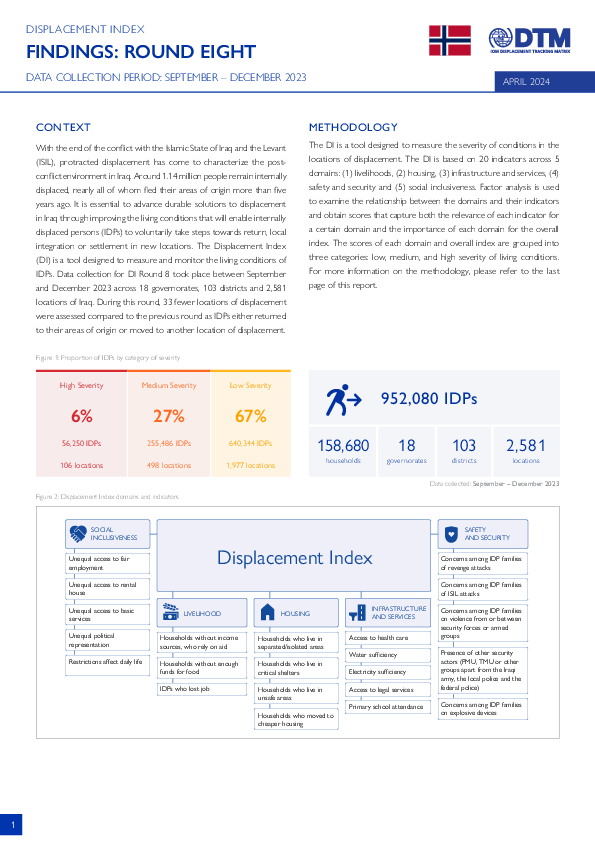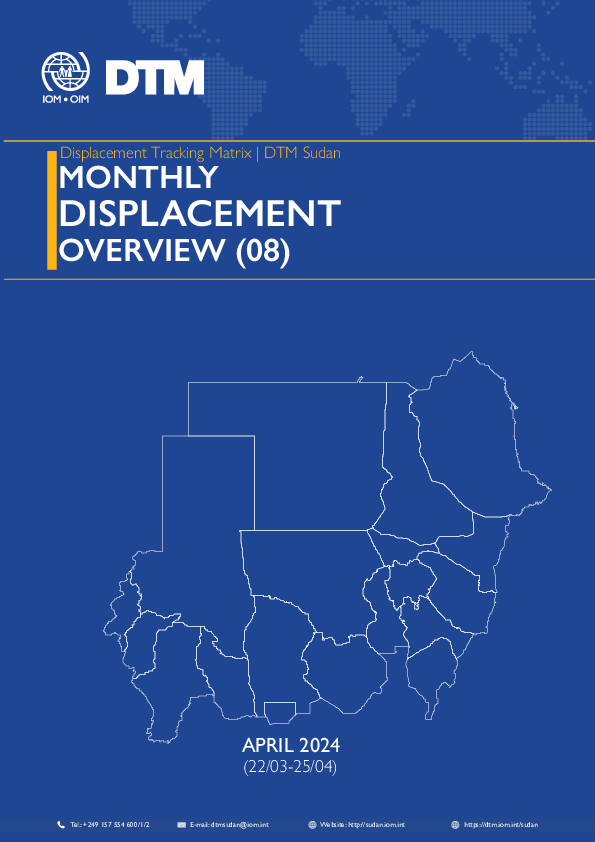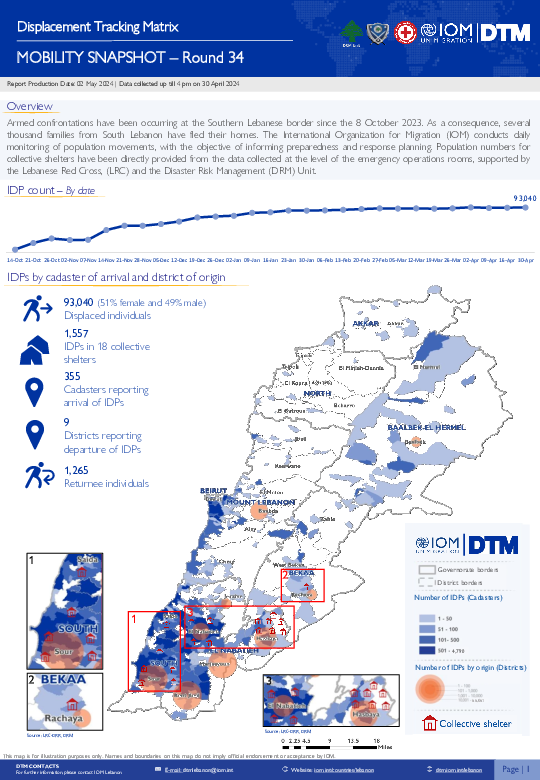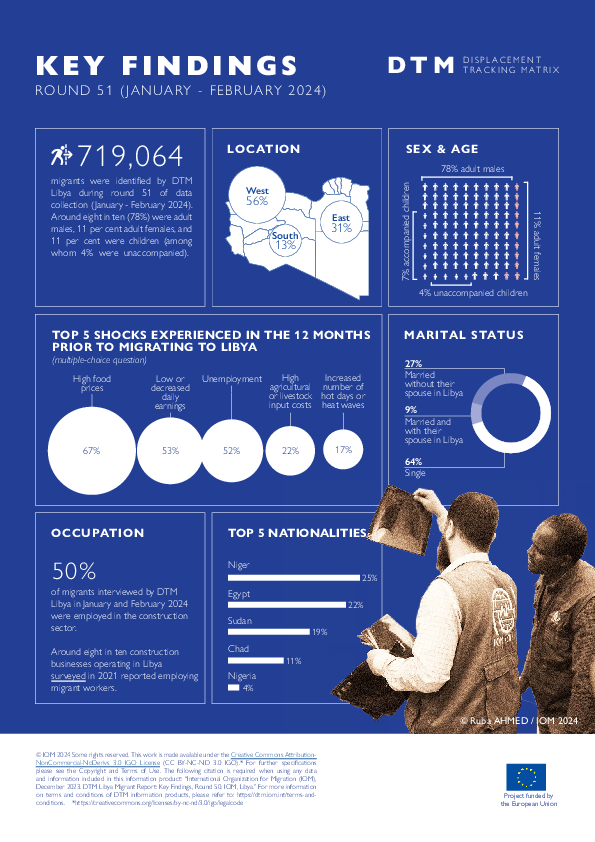-
Countries
-
Data and Analysis
-
Special Focus
-
Crisis Responses
Baseline Assessment

Contact
DTM Central African Republic, DTMRCA@iom.int
Language
French
Location
Central African Republic
Snapshot Date
May 30 2024
Activity
- Mobility Tracking
- Baseline Assessment
La Matrice de suivi des déplacements (Displacement Tracking Matrix, DTM, en anglais) est un outil de l’Organisation internationale pour les migrations (OIM) permettant de faire le suivi des déplacements et des mouvements de populations et d’avoir une meilleure compréhension de leurs besoins ainsi que de leurs profils, intentions et accès aux services. L’objectif de la DTM est de capturer et d’analyser, de manière régulière et à différents niveaux, les données relatives aux flux de populations et de disséminer ces données auprès des autorités et de la communauté humanitaire. Dans ce cadre, la DTM développe et partage divers produits d'information (rapports, analyses, tableaux de bord...) compilant et représentant les données recueillies, de manière à en faciliter la compréhension. Dans le souci de maintenir ses produits d’information en accord avec les besoins de la communauté humanitaire en termes d’analyses, la DTM en République centrafricaine a conduit une enquête en ligne sur l’utilisation et la qualité perçue de ses publications. Vingt partenaires ont donné des réponses à cette enquête. Le présent « Dashboard » en résume l’essentiel.
Contact
dtmlebanon@iom.int
Location
Lebanon
Activity
- Mobility Tracking
- Baseline Assessment
Period Covered
Oct 10 2023 -Apr 30 2024
Since October 8 there has been an increase in cross-border incidents between Israel and Lebanon, resulting in the displacement of people both within the South and elsewhere within the country. Since October 10, the Displacement Tracking Matrix (DTM) has been conducting the daily monitoring of population movements. The objective of the exercise is to inform preparedness and response planning.
Aggregated data is available through the DTM API: https://dtm.iom.int/data-and-analysis/dtm-api
A more detailed version of this dataset is available, to get access kindly click on the 'Request Access' button
Population Groups
IDPs
Returnee (Previously Internally Displaced)
Survey Methodology
Unit of Analysis Or Observation
Admin Area 2
Admin Area 3
Household
Individual
Type of Survey or Assessment
Key Informant
Keywords
Geographical Scope Full Coverage
Administrative boundaries with available data
The current dataset covers the following administrative boundaries

Contact
DTM Iraq, IraqDTM@iom.int
Language
English
Location
Iraq
Period Covered
Sep 01 2023
Dec 31 2023
Activity
- Mobility Tracking
- Baseline Assessment
The Displacement Index Report Round Eight assesses the living conditions of IDPs. This report presents the findings of data collection covering between September and December 2023. Data collection for DI Round 8 took place across 18 governorates, 103 districts and 2,581 locations of Iraq. During this round, 33 fewer locations of displacement were assessed compared to the previous round as IDPs either returned to their areas of origin or moved to another location of displacement.
Out of the 2,581 locations assessed in Round 8, 106 locations present severe conditions. These locations host 6 per cent of the IDP population, or 56,250 individuals. A further 498 locations are classified as medium severity and host 27 per cent of the IDP population (255,486 individuals) and 1,977 locations show low severity conditions with 67 per cent of the IDP population (640,344 individuals).
Contact
DTM Sudan, DTMSudan@iom.int
Location
Sudan
Activity
- Mobility Tracking
- Baseline Assessment
Period Covered
Mar 22 2024 -Apr 25 2024
- DTM Sudan estimates that 6,786,816 individuals (1,352,268 households) have been recently internally displaced as of 25 April 2024.
- IOM DTM also reports that an estimated 2,075,369 mixed cross-border movements have been made into neighbouring countries.
- Since 15 April 2023, 46 per cent of the IDP caseload sought refuge in the Darfur and Kordofan regions, whereas 53 per cent were observed across the Northern, Eastern, and Central states.
- The majority of the IDP caseload (65%) were seeking shelter with the host community.
- While food remains the highest priority need, health and non-food items are also growing concerns.
A more detailed version of this dataset is available, to get access kindly click on the 'Request Access' button
Population Groups
IDPs
Survey Methodology
Unit of Analysis Or Observation
Admin Area 3
Site or Location
Type of Survey or Assessment
Key Informant
Keywords
Geographical Scope Partial Coverage
Administrative boundaries with available data
The current dataset covers the following administrative boundaries

Contact
iomkyrgyzstan@iom.int
Language
English
Location
Kyrgyzstan
Period Covered
Dec 01 2023
Dec 31 2023
Activity
- Survey
- Flow Monitoring Survey
- Mobility Tracking
- Baseline Assessment
Мобилдүүлүктү көзөмөлдөө матрицасы (MКM) – бул калктын жер которуу жана мобилдүүлүгүн көзөмөлдөгөн жана ага мониторинг жүргүзгөн система. Бул система калктын жер которгон жеринде же жер которуу учурунда келип чыккан муктаждыктарын жакшыраак түшүнүү максатында, тынымсыз жана системалуу түрдө маалыматтарды топтоо, анализдөө жана ал маалыматтарды жарыялоо максатында иштелип чыккан.
2023-жылдын июнь-август айларында МКМ калктын мобилдүүлүгүнө көз салуу, жер которгондордун саны, эмгек мигранттарынын жана кайтып келген мигранттардын жайгашкан жери, миграциянын себептери, кайсы өлкөлөрдөн кайтып келгендиги жана миграцияда канча убакыт болгондугу жөнүндө маалымат берүү үчүн Кыргызстанда Мобилдүүлүк боюнча баштапкы баалоо (МБББ) экинчи айлампасын өткөрдү. МКМ ЭАМУна жана анын өнөктөштөрүнө ресурстарды максималдуу көбөйтүүгө, артыкчылыктуу багыттарды аныктоо жана максаттуу, далилдүү, мобилдүүлүкө тиешелүү туруктуу миграция саясатын жана иш пландарын иштеп чыгууга мүмкүндүк берет.
Contact
DTMDRC@iom.int
Location
Democratic Republic of the Congo
Activity
- Mobility Tracking
- Baseline Assessment
Period Covered
Mar 29 2024 -Apr 26 2024
The displacement data collected in this eighteenth crisis analysis shows a decrease in the number of people displaced by the M23 crisis compared with the previous publication (see report). The number of displaced people decreased from 1,561,676 on 29 March 2024 to 1,524,179 on 26 April 2024 (detailed data here). This 2% decrease is due to clashes in villages already emptied of their populations in the Kamuronza and Mfunyi-Shanga groupements, and on the Kibirizi and Rwindi axes in Rutshuru territory. A large number of people displaced by the fighting in Rutshuru and Masisi territories are already displaced from their region of origin, and are therefore counted as secondary displacements.
Population Groups
IDPs
Returnee (Previously Internally Displaced)
Survey Methodology
Unit of Analysis Or Observation
Admin Area 2
Admin Area 3
Admin Area 4
Type of Survey or Assessment
Key Informant
Keywords
Geographical Scope
Administrative boundaries with available data
The current dataset covers the following administrative boundaries

Contact
DTM Sudan, SudanDTM@iom.int
Language
English
Location
Sudan
Period Covered
Mar 22 2024
Apr 25 2024
Activity
- Mobility Tracking
- Baseline Assessment
Overview
IOM DTM Sudan presents its eighth Monthly Displacement Overview. This publication provides an account of Sudan’s displacement context since 15 April 2023 – outlining population mobility and displacement, as well as the present and evolving needs of IDPs across Sudan. It provides further contextual analysis for all 18 states for the period between 22 March and 25 April 2024.
Rationale
Recognizing the need for more detailed insights into the IDP situation, including the priority needs, access to services, movement intentions, and demographic breakdowns of the affected population, DTM Sudan has undertaken a comprehensive review of our data collection tool. In collaboration with a wide range of internal and external stakeholders, we have developed a new tool to better inform humanitarian response operations, aligning with the DTM global methodology. Leveraging our extensive network of approximately 367 field-based enumerators and a robust system of over 3,698 key informants across the country, DTM gathered data on IDPs across 7,251 locations, in 182 of Sudan’s 189 localities, across all of Sudan’s 18 states, during March 2024.
Key Findings
- DTM Sudan estimates that 6,786,816 individuals (1,352,268 households) have been recently internally displaced as of 25 April 2024.
- IOM DTM also reports that an estimated 2,075,369 mixed cross-border movements have been made into neighbouring countries.
- Since 15 April 2023, 46 per cent of the IDP caseload sought refuge in the Darfur and Kordofan regions, whereas 53 per cent were observed across the Northern, Eastern, and Central states.
- The majority of the IDP caseload (65%) were seeking shelter with the host community.
- While food remains the highest priority need, health and non-food items are also growing concerns.
Contact
dtmlebanon@iom.int
Location
Lebanon
Activity
- Mobility Tracking
- Baseline Assessment
Period Covered
Oct 10 2023 -Apr 16 2024
Since October 8 there has been an increase in cross-border incidents between Israel and Lebanon, resulting in the displacement of people both within the South and elsewhere within the country. Since October 10, the Displacement Tracking Matrix (DTM) has been conducting the daily monitoring of population movements. The objective of the exercise is to inform preparedness and response planning.
Aggregated data is available through the DTM API: https://dtm.iom.int/data-and-analysis/dtm-api
A more detailed version of this dataset is available, to get access kindly click on the 'Request Access' button
Population Groups
IDPs
Returnee (Previously Internally Displaced)
Survey Methodology
Unit of Analysis Or Observation
Admin Area 2
Admin Area 3
Household
Individual
Type of Survey or Assessment
Key Informant
Keywords
Geographical Scope Full Coverage
Administrative boundaries with available data
The current dataset covers the following administrative boundaries

Contact
dtmlebanon@iom.int
Language
English
Location
Lebanon
Period Covered
Oct 10 2023
Apr 30 2024
Activity
- Mobility Tracking
- Baseline Assessment
Since October 8 there has been an increase in cross-border incidents between Israel and Lebanon, resulting in the displacement of people both within the South and elsewhere within the country. Since October 10, the Displacement Tracking Matrix (DTM) has been conducting the daily monitoring of population movements. The objective of the exercise is to inform preparedness and response planning.

Contact
DTM Libya, DTMLibya@iom.int
Language
English
Location
Libya
Period Covered
Jan 01 2024
Feb 29 2024
Activity
- Flow Monitoring
- Mobility Tracking
- Baseline Assessment
This infographic presents the key findings of Round 51 of the mobility tracking and flow monitoring components of the Displacement Tracking Matrix (DTM) programme in Libya.
Pagination
- Previous page
- Page 28
- Next page
